#more joel meyerowitz
Text
welcome to forget me not valley, which eligible man(datory husband) will you be pursuing


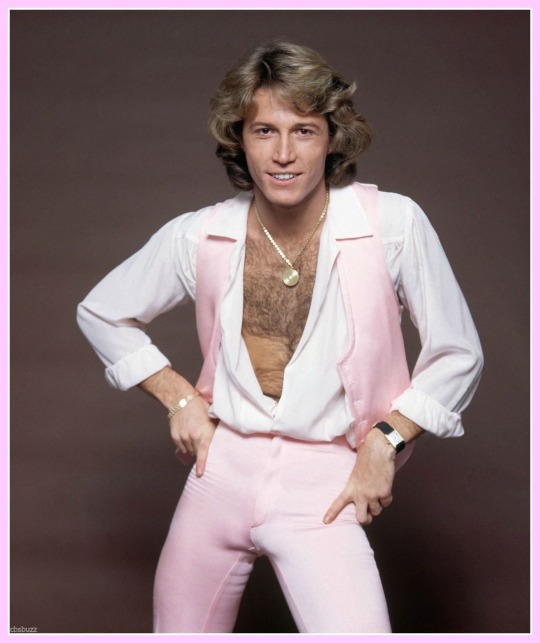
#queue tea pie#part of my 70s fashion research#1st picture by Joel Meyerowitz 1975 in new york#with gustafa i combined several ideas but this is why i decided on his hat being that shape. the way it folds looks like his snufkin hat :3#2nd picture is alvin stardust also in 1975#i always see him compared to elvis but in terms of appearance he reminds me more of this guy#i think marlin would wear leather in the winter. if you’ve ever ridden a motorcycle you know how it be#3rd is andy gibb in 1978#did not use because it was 1. already just a palate swap of what rock wears in the original games#2. That#it’s in character but still
55 notes
·
View notes
Photo


BOOK REVIEW: THE PLEASURE OF SEEING by Joel Meyerowitz and Lorenzo Braca (2023)
Spring has now sprung and so reviewing this new bloom by Damiani seems apt as, THE PLEASURE OF SEEING, is dressed in beautiful, daffodil yellow.
In Europe, a 23rd March release, echoing Joel Meyerowitz’s own birthday (6th) and May is the “day” (of release) in the USA.
Photographer Meyerowitz’s main claim to fame is that he dared to take colour pictures early on in his long and successful 60 year career, when most others were still holding the developing world at arms length and clicking away in black and white. That said, Meyerowitz did also capture the monochrome, and I’ve included my personal favourite above this write-up.
Inside this 216 pages of hardback you’ll discover extremely detailed pages describing all the wonderful photographs within. Paragraph after paragraph throwing light on any shade, thanks to these recorded conversations with Historian and Photographer, Lorenzo Braca.
A very special book indeed showcasing some of the very best landscape, portrait and landscape photography - so perfectly.
Signed copies are also available.
Rating: 10/10
More information (and how to buy) here:
https://www.damianieditore.com/en-US/product/848
Mark Watkins, Dare radio, 31 March, 2023.
2 notes
·
View notes
Text
Street Documentary Photographers
Gilbert Duclos
Duclos worked on a photo series called “Cités” , with the theme of people inhabiting urban environments. Taking from the tradition of documentary photography, his images lead us on the streets of famous Western Cities in an urban journey. Taken randomly, his black and white photos, which are all vertical, reflect Duclos’ curiosity and his influence.
From 1954 to 1961, his father was the General Manager of Montreal's Belmont Park and every Sunday of the summer, Gilbert was taken to the amusement park so that he could see his father hard at work. The raucous, joyful and colourful crowd had a strong influence on the future vision of this burgeoning photographer. Taking several jobs to help pay his way after he had put his studies on hold and left for Paris, he worked as a vélosolex courier in Paris, an upholsterer for his craftsmen friends and as a mover. He began taking photos in Paris using the Kodak Instamatic that had been given to him by his mother.
In his free time, he explored Paris and perfected the art of loitering on the city’s grand boulevards and terraces. The time he spent in Paris played a key role in his approach to street photography and I admired the simplicity of the black and white silhouettes that were made into art.

Mitch Epstein
“Photography remains a tool with which I form and sharpen my response to the world around me. Anything and everything is photographable in an infinite number of ways. That excites me.”
One of the many members of the transformational generation of mostly American photographers who engaged with and challenged the conventions of modernist photography of the first half of the twentieth century. Like other luminary photographers of the late 1960s and early 1970s, Epstein pursued a more individualistic, subjective values system in his artwork and did so with colour film: “I started to work in colour, which was a radical, and some thought foolish, move in 1973. Colour photography was not yet a medium for serious photography...”
Epstein helped pioneer fine-art colour photography in the 70’s, his photographs are in several major museum collections, this includes the New York’s Museum of Modern Art, Metropolitan Museum of Art and Whitney Museum of American Art, Tate Modern in London and more.
I enjoyed admiring Epstein's work as figures in his images must seem ordinary in person but through the lens of the camera, it almost feels like a staged shoot or something unusual, which what drew me to it.


Joel Meyerowitz
“Some photographers go to the streets, and other photographers go to a studio. Some pretend it is a movie and other photographers walk into the world and say “show me”.
Those select few who are willing to go to chaos with the high hope to interact with the moment, where life will get clarified for them.They can welcome ambiguity and surreal aspects of this kind of chaos.
Even though it is chaos out there, they will have a moment of clarification
There are plenty of people who don’t see it, because they don’t look that way.”
A believer of seizing the moment, Joel Meyerowitz is a photographer whose work has appeared in more than 350 exhibitions in museums and galleries around the world. Born in New York in 1938 and began photographing in 1962, making him one of the first proponents of colour photography in the mid-1960s. Meyerowitz played a key role in the evolution of the attitude towards the use of colour photography, whose resistance to acceptance was almost universal.
I admired his work as he practices making art out of what was in front of him. The quote said it all.
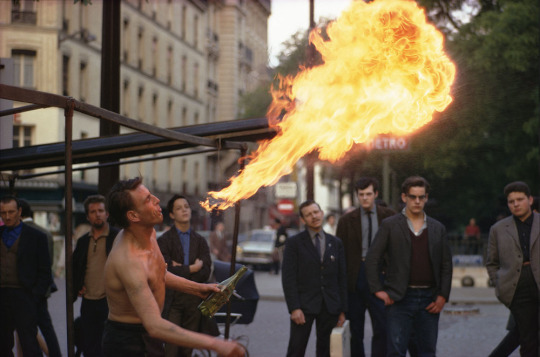
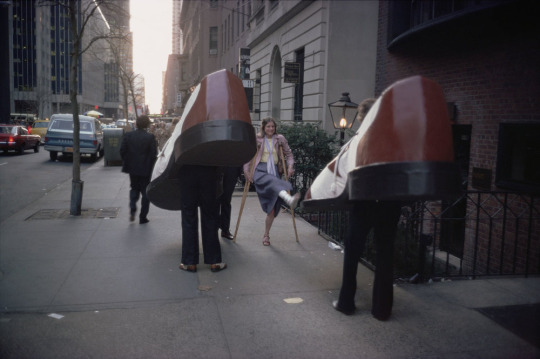

2 notes
·
View notes
Text
Paper Movies

Joel Meyorwitz

Joel Meyerowitz, New York City, Times Square, 1963,
Be willing to go out into chaos and interact with moments.
Go out there and watch life and what people do physically.
Street photography is a way of learning to read your culture.
Responding to things and learning what they mean to you.
Boogie

Group Guns 1, Gangs, by Boogie
Have your camera with you at all times, you never know when something is going to happen.
When you are behind the camera you are not a participant, you are an observer.
It's about becoming what you are shooting.
The deeper you go, the better pictures you take.
After you die, you leave photography behind, like you become immortal.
Max Kozloff
I New York photographer have to take into account, noise, movement, combustion, energy and danger. To record a human setting.
Martha Cooper

Street Play, Martha Cooper.
Looking for public spaces, how people are using the space and surviving.
Preserving the spaces.
If she didn't photograph graffiti a lot of it would be lost.
Capture different backgrounds.
You capture something that might be of interest in the future.
With digital you should shoot everything
Jill Freedman
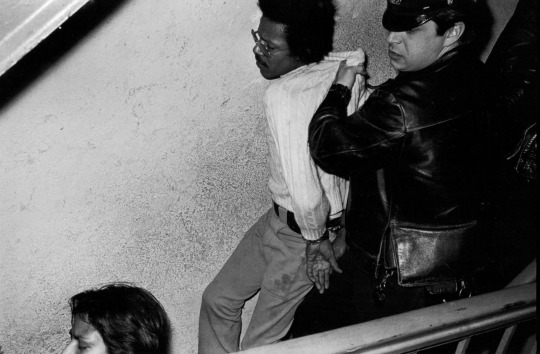
Street Cops, Jill Freedman
Wanted to capture what it meant being a good cop in New York City.
She had to be at the scene first to get the shot.
She worked at being invisible
"don't do the crime, don't get your picture taken"
It's a great privilege to take a great picture of someone.
It's the only tool that will stop time.
Jeff Mermelstein

Sidewalk Woman with Money in Mouth, Jeff Mermelstein
Loves photographing people, who they are and what they're doing.
The most exciting thing about street photography is the element of surprise.
He likes that people think his photography is funny.
His process is instinctual, when on the street.
You create your luck and there is a lot of work involved.
Taking pictures without permission causes problems.
Helen Levitt

Two old New Yorkers eating watermelon , 1971. Helen Levitt
She was able to conceal herself because of her size, her small camera and agile movement.
Rebecca Lepkoff

Group #2, Lower East Side, 1948, Rebecca Lepkoff
She photographed where people lived, how they lived and what they were doing, It was about humanity.
Space in photography has a lot to do with dance. The space you have on the stage.
The camera makes a document of how things are.
During the time of The Photo League, many great photographers came there to talk to people.
Clayton Patterson
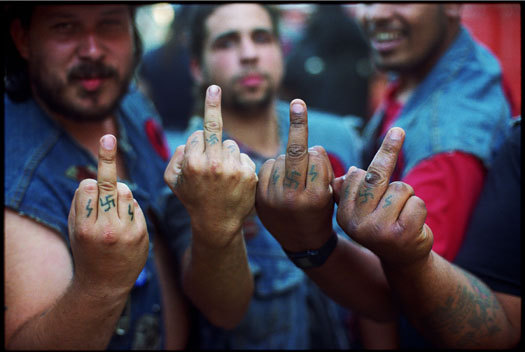
Evolution of The Lower East Side, Clayton Patterson
New York had a class of people that he could identify with and he found the energy comforting.
He was consistent in photographing people outside his front door, his neighbourhood and put the pictures on his window.
He photographed street people.
"It's not about you as an individual, it's about you as a community"
Photography is about preserving the moment for the future, an activist tool and it gives you access to places.
He went to jail, because he didn't hand over video footage to the police.
He captured the social factor that most people overlook.
He wanted his work to be relevant and significant.
He's had confrontations, been beaten up by the police, cut and had his teeth knocked out.
Eliott Erwitt
"there are to many bad pictures in the world but there is always room for good ones"
Good pictures illuminate, entertain, amuse and make people feel.
"digital manipulation kills photography"
With digital photography, everybody can take an image, not everyone can take a good one.
Bruce David
He lived in his dark room.
All he cared about was taking pictures.
He gave his subjects his pictures, in return for privacy, and to make them more comfortable with him being there.
People are glad you're there to see them, because no-one is paying attention.
Bruce Gilden
He likes film noir and shadows
He photographs characters, people with striking detail.
He jumps into peoples faces with a flash to isolate them and to separate the background from the foreground.
He shows the stress, energy and anxiety of the city.
You can be invisible by being close, when you are close, sometimes people don't think you are taking their picture.
People in his pictures are symbols for what he sees, as an expression of the world.
Jamel Shabazz
He finds it difficult taking a picture without the person knowing. There is something magical about approaching a stranger and convincing them that you are sincere.
He uses his camera everyday.
He compliments his subjects first, gives them the print as a marketing tool.
He wanted to capture homelessness and prostitution.
Mary Ellen Mark

Attitude: Portraits, 1964–2015, Mary Ellen Mark.
She finds out when they are events and shoot around them
The hardest form of photography is street photography, because you have to think on your feet.
Doesn't believe in cropping but making the picture in camera.
Her goal is making iconic images
3 notes
·
View notes
Text
QCQ 1
"Protecting the Right to Photograph, or Not to be Photographed" by Olivier Laurent and the film "Everybody Street" by Cheryl Dunn both tackle the subject of photography, but from different perspectives and mediums. While Laurent's essay delves into the legal and ethical considerations surrounding the act of photography, Dunn's film celebrates the art of street photography and the lives of the photographers behind the lens. Despite their differences, both works touch upon the complexities of image-making and its impact on society.
In Laurent's essay, he discusses the delicate balance between the right to photograph and the right to privacy. He states, "While everyone agrees that photographers should be allowed to work freely in public spaces, the line between what’s ethical and what’s not often blurs." This quote encapsulates the central dilemma addressed in the essay - the tension between individual freedoms and the potential infringement upon the privacy and dignity of subjects.
On the other hand, Dunn's film celebrates the vibrant world of street photography and the diverse array of photographers who roam the streets capturing moments of everyday life. In one scene, legendary photographer Joel Meyerowitz reflects on the spontaneity of street photography, saying, "You’re alive to the world. You’re wide open. Anything can happen." This quote captures the essence of street photography as a dynamic and immersive practice that embraces the unpredictability of life on the streets.
While Laurent's essay focuses on the legal and ethical considerations of photography, Dunn's film offers a more artistic and humanistic exploration of the craft. Both works, however, raise important questions about the power dynamics inherent in image-making and the responsibilities that come with wielding a camera in public spaces. Ultimately, they contribute to a deeper understanding of the complexities surrounding the act of photographing and being photographed in contemporary society.
0 notes
Text
Wait for it Research Task
THE DECISIVE MOMENT
Essentially, The Decisive Moment refers to a single fleeting moment that is captured by a photographer who was in the right place at the right time. Capturing this moment is what makes the image strong and interesting and completes the composition, where as if it were to be missing from said composition, or the moment missed, the resulting image would not be as successful/lack interest.
I am going to be discussing two photographers who both capture these decisive moments in their work, but have two notably different approaches to doing so.
HENRI CARTIER BRESSON
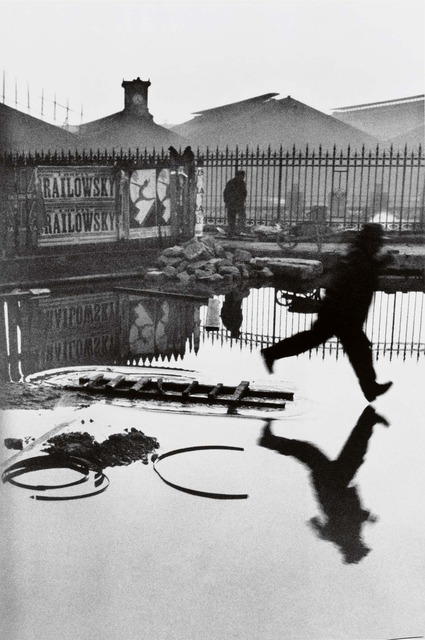
"In photography there is a new kind of plasticity, the product of instantaneous lines made by movements of the subject. We work in unison with movement as though it were a presentiment on the way in which life itself unfolds. But inside movement there is one moment at which the elements in motion are in balance. Photography must seize upon this moment and hold immobile the equilibrium of it." - Henri Cartier-Bresson.
Bresson was a French photographer born in 1908. He is a very well renowned photographer whose career spans many decades and whose work has inspired many other photographers. He is seen as a pioneer of street photography, specifically the area of capturing decisive moments, of which he coined the term himself, and is featured heavily in his work.
Starting out in the creative field with an interest in painting, he soon became deeply passionate about photography with his first camera, and thereafter camera of choice being a Leica. In 1947, he went on to help form Magnum photos -an international photographic cooperative focusing on photojournalism that covers real world issues and events, and is still present to this day.
It is clear from his looking at work that his usual approach to capturing his decisive moments is to see the compositional effectiveness of the spaces around him, then wait for these moments to happen, and then capture it with perfect timing - effectively framing them within the composition.

The photographer has captured the energy from the pigeons swirling around the woman quite well, the freezing of them in the air adds to the anticipation and is a very effective "wait for it" moment. The swirling railing on the side of the frame also is satisfying to look at and leads the viewers eye up the frame from top to bottom.
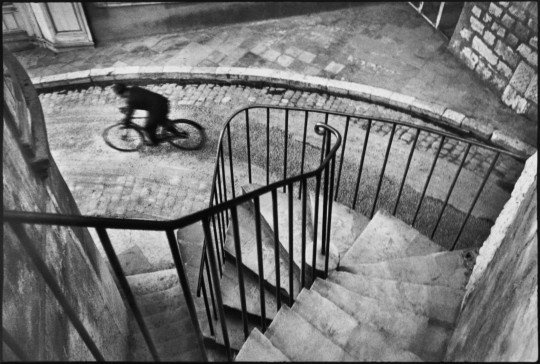
Much like the last image, the swirling of the stairwell leads the viewer from the bottom of the frame, then across the composition up to the boy on the bike, who is framed perfectly within the opening between the railings. Very compositionally effective. The motion blur of the subject also implies how the photographer waited for the perfect time before taking the photo, adding to its effectiveness.
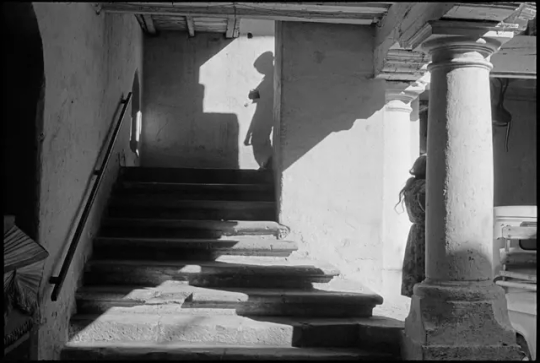
Bresson's use of light here is very good. The use of light and shadow to create these diagonal lines intersecting lead the viewers eye all across the frame and makes for a very balanced composition. The two figures being featured, with one in the form of a shadow, insinuates some form of a relationship between the two which isn't clear, which in turn, draws the viewer in more.

in this image, I like the use of the geometric shapes in the form of the doorways and the shadows they cast, and framing the boy between them, who is a natural shape stands out more in contrast. Narrative is also created by the fact he is running and invites the viewer to ask where he is running to ? (or from).
JOEL MEYEROWITZ
Meyerowitz is an American Photographer born in 1938, and is most well known for his street photography capturing the life of the city streets of his birthplace of New York. He is also seen as a pioneer of colour film, as it features heavily in his street photography from the mid 70s onwards.
After Graduating from Ohio State where he studied painting, Joel worked as a junior Art Director for a brief time until working alongside the prolific commercial and street photographer at the time Robert Frank on a commercial shoot, where he was so deeply inspired by watching him work that he decided to become a street photographer almost immediately after.
He began shooting the streets using a Leica M (which he has continued to use throughout his career) with 35mm Black and White film, at a time when photographers such as Diane Arbus and Garry Winogrand were doing the same, with him and Winogrand accompanying each other when taking the streets many times, and most likely drawing inspiration from each others work. At this point, he preferred shooting wide angle (24-35mm) using film of ISO 1200 so he could increase his shutter speed to freeze his subjects of the fast-paced streets, and document the action right as it was happening, not being shy to get up close and personal to people and events to see what he could capture - this is his approach to capturing "the decisive moment".
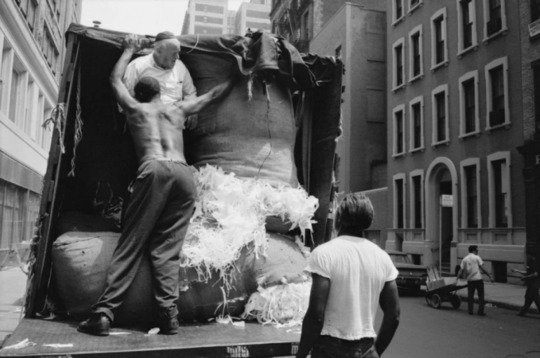
It wasn't long before Meyerowitz was going out shooting with two Leicas, however - one black and white and one colour, and by the mid 70s, almost all of his street photography work was in Colour. However, the slower ISO of the colour film at the time meant he had to switch up his normally quick approach and slow down and take in the scene more. It was because of this that he developed an interest in large format photography, branching out into capturing scenes with extreme detail, lack of grain, and incredible tonal range.
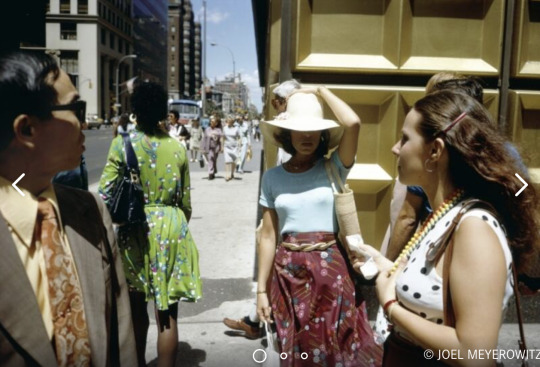
This was during a time when colour film photography was still not regarded as "serious art" and that black and white was still the only professional practice. Meyerowitz rejection of this notion and his incredible work with the medium is why he played a key role in the popularisation of colour photography as a whole.

This is probably my favourite photo by Meyerowitz, the use of light and shadow lead the viewers eye straight to the tiger which is the clear focal point of the image, the storytelling created by this featuring of a random tiger in the middle of a city (even thought isn't real) while the people walk around it completely unfazed is what makes it so effective as a street photography image.
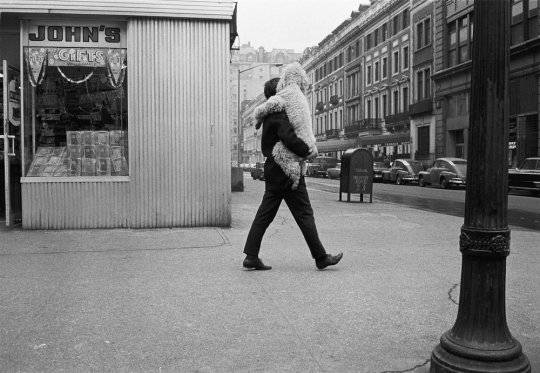
The comedic narrative provided by the man holding the dog in this is clearly the focus of this image. The way he carries it like a child together with the size of the dog and the fact it is looking away from the camera gives it an almost human child-like quality which is also very unique. The dogs white fur contrasts well with the mans black clothes which I also like.
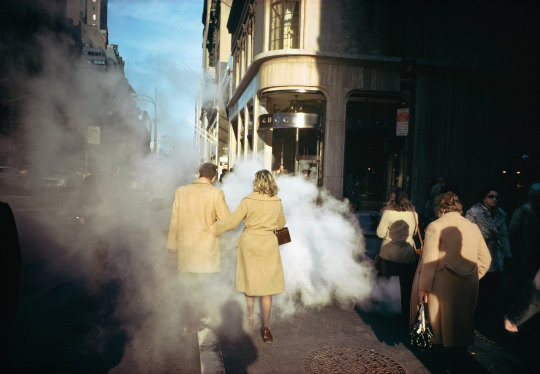
I can tell the photographer chose to take this picture at the perfect time and capture "the decisive moment", being the cloud of steam the couple are about to walk into which draws the viewer in. The steam also captures a lot of the beam of sunlight entering the frame which makes it stand out more and makes the nice lighting another key feature of the image. Moreover, the way the two shadows of the peoples head fall perfectly onto the other two peoples backs show there is a lot to look at in this photo that is visually pleasing.

This very unique and rather sweet moment captured by the photographer creates a very ineteresting parallel between the baby and the monkey looking at each other, bringing about a narrative of parenthood and how unconventional a family can be. The baby being above and the monkeys being below on each side of the frame helps balance out the composition.
0 notes
Text
Week 9
Create call sheet for coming weeks (one for each shoot)
Draft Postioning stament ( who are you as a photography, who are you, where you are from) on blog 100words
Workplace for next 2 weeks (talk about next couple weeks)
Play around with Lightroom classic
Refecltive stamment needed for hand in - 500 words (start as soon as possible)
Joel Meyerowitz: Pulse of the street
The street = the public
Born in the bronx - working class
Kids always play on the street
Pay attention on the world, father taught him to see the world, how it works
Everything is there for you on the street
Stop and take photo, has a feeling that he needs to stop and capture the moment
Submission requirements
Blog, pdf portfolio , 500 statment - Thursday 26/10
Raw Files for portfolio - Lightroom Classic
Relate cross content back into your stament
Blog url in comment section
Zip folder for raw files
Workplace for Week 9-12
Shoot more images of the same thing, triple my amount of images of the same thing
Reshoot the laundry scene
Reshoot Skatepark shoes
Reshoot into the phonebook
Work on SLD and see if there is any work you are behind
Do call sheet for each shoot you do
0 notes
Text
Formative & 1:1 feedback_week 09
Formative feedback (what worked):
Scratched graffiti in b/w
Converging lines of road signs by local dairy
Colour palette of green/grey fence
Pops of colour throughout [I have been thinking about how I might approach this with regard to using b/w and colour strategically > more research about b/w though]
'FREE' graffiti with the 'NO ENTRY' signs = good contrast
Analogue testing
Foggy morning photos
Development toward documentative style by Brendan Kitto and gentrification
Some points from in-class teaching & feedback from Emil:
Teaching notes:
Create a group of photos keeping in mind "all killer no filler" if it's average leave it out - you want the great photos in the sequence to all need to be there, not just cause or as random fillers.
This is a photo essay, approach it as such, you need both photos as well as analysis and reflection on how you got to those and what story they are telling.
When writing the contextual analysis for summative > think appraisal (art critic level not just describing what you see or saying that you like it > recompose the image / what makes it and why? > take a position on your work = story. Process your ideas (there are not outputs without inputs = research)
Research > make > think > repeat.
Feedback notes:
Look at what I have and draw out what it is saying, rather than imposing something onto it and constructing too much.
Do some research on Auckland photographers and Mt Roskill history > how can these imform my story? What has been said (narratives & histories) & photographed of Mt Roskill before and what stories do they tell?
Poetically document Mt Roskill as a place > fragmentary view > speak to the change? urban change, housing, social etc. [links nicely with Brendan Kitto and my idea around the story of gentrification in MR]
The fragmentary view > small snapshots that show the elements of change throughout [still consider hourglass > perspective / zooming in and out].
Photographer to research > Joel Meyerowitz
Technical feedback:
Bring out some highlights to make areas pop
Increase contrast (some colours are a bit dull)
Lighten shadows to bring out detail and colour
Work on cropping > unecessary / distracting details = crop out
Cropping > where do you want your viewer to look? what stands out & tells the story? what elements do you want to use to tell the story?
0 notes
Text
Contextual - Editorial.
Discussion of fashion stories within editorial pieces and magazines. Choose one fashion story and describe how it is themed.
Joel Meyorowitz is a well renowned street photographer, distinguished often by the surrealist nature of his photography. Even his standard portrait always has a strange quality to it, outwith traditional styles of street photography. You can definitely see Meyerowitz' style of photography shine within this editorial. The street context of the shots are akin to many of his other publications, alongside the very loose use of a reoccurring theme/storyline.

Joel meyerowitz for Jil Sander 2021
There is a structural theme surrounding this editorial; many of the images portray models standing in square archways and doorframes. The daylight outdoors shots tend to showcase some undersaturated, pale yellows and pinks, while the indoor shots are more neutral toned. There is a bit of a ‘Wes Anderson’ feel to some shots, but I am unsure if it was a purposeful inspiration. The photographs weave inside and outside, as well as during the day and during the night while all showing one of two models. Every shot is of a single person, Meyerowitz never chooses to bring them together for any image. He may be depicting a sense of loneliness, particularly in the nighttime shots. However, I feel some serenity in the daylight images as well.
The shots change frequently, in fact there is less that stays the same throughout than what changes for variety. Meyerowitz swaps between two models, multiple locations and different outfits.

0 notes
Text
Paper Movies Task
What is the significance to us of the ‘Photographic Journey’ in three decades from the 1950’s?
Changes overtime
How photography changes from large format to 35mm, colour to black and white, analogue to digital.
Why has Robert Frank’s book ‘The Americans’ had such an impact on modern photography.
What ‘narrative’ is pervasive throughout his book?
Shows outsider perspective
Showed what adverts didn’t want to
Flags and crosses – narrative of optimism that has died
Joel Sternfeld is seen using what type of camera? Why would he be using this as opposed to digital?
Large format/ View camera – he is set up in the same spot
Gives him more control of colour
William Klein had one particular photographic outlet for the expression of his photography – How would you describe his attitude to photography?
Risky, chaotic, don’t care attitude
Takes the blurs and grain and turns it into something
Thinks more about the way the image can be used and displayed
Wants to break boundaries
What made Joel Meyerowitz reject Henri Cartier Bresson’s decisive moment concept for his New York Street Photography?
He thinks you can’t possible plan things and that you should just believe that you can see things within fractions of a second
Iconic NY Street Photographers Garry Winogrand, Diane Arbus & Lee Friedlander and English Photographer, Tony Ray Jones who was heavily influenced by the above noted the key pointers to being a successful Street Photographer.
List them here.
Showing expression
Talk to others
Get closer
Be patient
Don’t take boring photographs
Be agreesive
Why have British ‘street photographers’ gravitated to the beach as an ideal location for their subject matter?
More spontaneous
More candid
Where people are more relaxed and off guard
‘Surface rather than soul’. What does that mean to you?
The existing place rather than the unplannable actions taking place
No deeper meaning
What are your observations of the road trips of Stephen Shore & Joel Sternfeld.
They photographed absolutely everything
Why would William Eggleston be regarded by photographers as ‘King’?
Photographed in Memphis Tennessee
Combines the unpredictability of the streets with the power of colour
His images have a painterly quality to them
0 notes
Text
Open Box - Photography Quotation of the Day by Joel Meyerowitz
Open Box – Photography Quotation of the Day by Joel Meyerowitz
View more photography quotations
Thank you for your visit
goffjamesart.wordpress.com
Art Music Photography Poetry Quotations
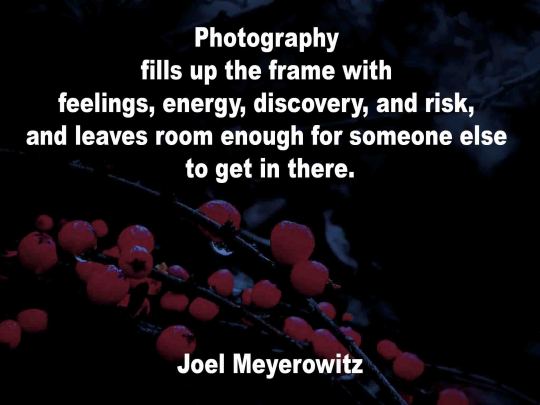
View On WordPress
#Art Music Photography Poetry Quotations#Goff James Art Music Photography Poetry Quotations#goffjamesart#Joel Meyerowitz#Photography#Quotation
0 notes
Text
Vivian Maier Photography

A street photographer whose work and life I hugely admire is that of Vivian Maier. For those of you who haven’t heard her story, she worked and lived as a nanny her entire adult life– and shot street photography on the side for herself. She created incredible black and white and color work through the 1950’s all the way through the late 1990′s. She shot an incredible amount of images– that amount to over 100,000 negatives.

One thing I am particularly interested in is Vivian Maier’s working style. Based on her contact sheets (with her black and white Rolleiflex work), you can see that she was quite conservative. Most of the photos she took were just one shot of a scene. Sometimes when she thought the scene was really interesting, she would work the scenes and shoot up to 8 shots (more than half the roll of 12 shots in a medium-format film).
Vivian Maier’s Working Style
Based on her contact sheets (with her black and white Rolleiflex work), you can see that she was quite conservative. Most of the photos she took were just one shot of a scene. Sometimes when she thought the scene was really interesting, she would work the scenes and shoot up to 8 shots (more than half the roll of 12 shots in a medium-format film).
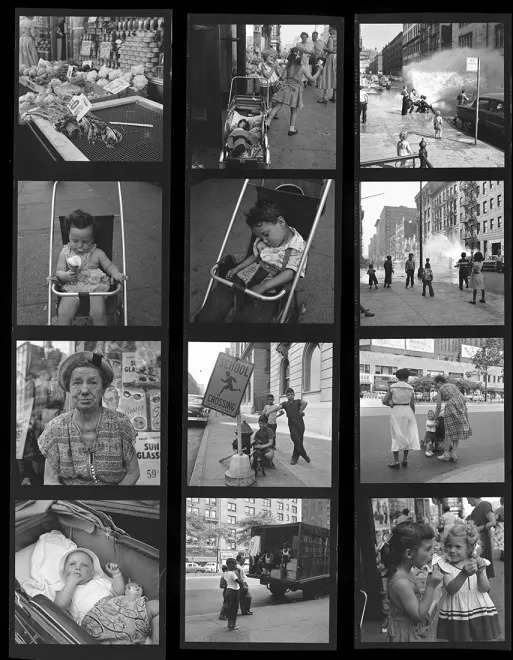
Shooting with her Rolleiflex, many of her shots shows she was unnoticed by her subjects. However some of the photos, you can see that her subjects look at her curiously (showing that her subjects at least had some idea she was photographing them).
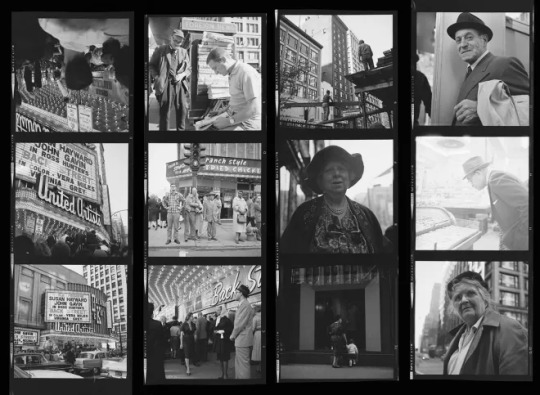
Some of the photos she took also looks like they were photographed with consent by her subjects. She might have briefly chatted with her subjects before taking their shot– as some of her subjects simply smile and look straight at Vivian.
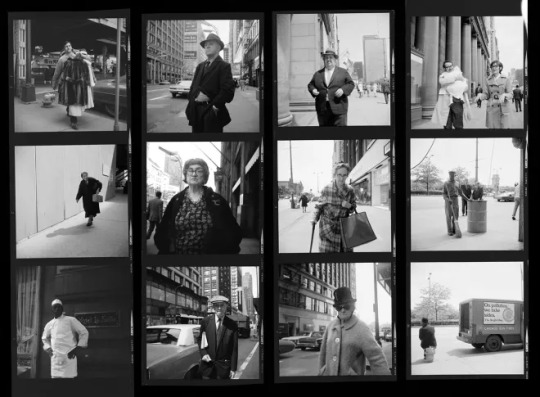
She also zone-focused while shooting (pre-focusing her lens to a certain distance and shooting with a relatively small aperture). She photographed people who were stationary– and also people who she found interesting as they walked by her.

In terms of her working distance, Vivian shot at different distances. Some of her photos are intimate portraits shot at a close distance (less than a meter away). She wasn’t shy to get close to her subjects to fill the frame. Other photos are shot more at a distance to show more of the environment and of an interesting scene.

Regarding subject matter, Vivian Maier photographed street scenes, portraits of people, interesting architecture, self-portraits, as well as random objects in the streets.

Her colour work differs much from her black and white work. First of all, her colour work looks more like the classic “street photography” you would see by the likes of Garry Winogrand and Joel Meyerowitz. It is much more spontaneous and has a specific focus on colourful scenes. She also shot most of her colour work on 35mm, which creates more dynamic framing in her shots. Most of her black and white work was on her Rolleiflex, which wasn’t as quick and nimble as her Leica and 35mm SLR cameras.
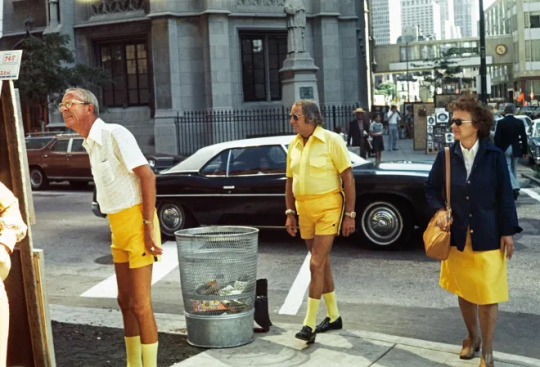
Below are some lessons Vivian Maier has taught me about street photography:
1. Shoot for yourself

One of the most important lessons I’ve personally learned from Vivian Maier is the importance of shooting for yourself. Maier never really showed her work to anybody else while she was still alive and shooting. It wasn’t until John Maloof discovered her work in a storage auction did her work reach a huge audience.
Nobody still really knows her motivations in her street photography because she never really talked to anybody about her work. Not only that, but she never left behind any written records regarding her motivations in street photography.
Regardless, it is clear that she shot street photography to satisfy something inside herself. She shot prolifically- at every chance that she got. Even though she did work full-time as a nanny, she used her time in-between chores and on the weekends to create her breathtaking images.
Takeaway point:
Sometimes we forget the most important person to impress with our photography is ourselves. With the proliferation of social media, we always feel the need to impress others. We want to get tons of followers, likes, favorites and admiration from others.
If Vivian Maier started shooting street photography nowadays, she would have probably stayed off social media. She would have shot purely to satisfy herself– and not worry or care what others thought of her work.
I think the beauty of street photography is sharing it with others. Even with Vivian Maier– I think it would have been a shame if nobody ever discovered her work. Her images inspire, in their simplicity and beauty of everyday life.
While it is admirable to create images to inspire other people– don’t forget that you want to impress and satisfy yourself. First shoot for yourself, and if others happen to enjoy your work– that is an extra plus.
2. Be prolific

Vivian Maier left behind 100,000+ negatives, much of which was undeveloped. When John Maloof first discovered her work, about 20-30,000 negatives were still in rolls, undeveloped from the 1960’s-1970’s.
Why did she have so much undeveloped work? Part of the reason was the fact that she was always moving and didn’t have much stability. Not only that, but she had financial issues her entire life– and she passed away nearly penniless.
I also think a part of the reason is the fact that her primary goal was to just go out and document the world. She might have thought that she could just do all the shooting while she was healthy, and could always end up developing and printing her work later.
Maier photographed constantly, over 50 years throughout mostly Chicago and New York. Her style changed and evolved over time, photographing street scenes in black and white, then working in color with more abstract scenes.
Letting her undeveloped work pile up is very similar to that of Garry Winogrand, who was also a prolific shooter. He was too busy shooting, that he didn’t have enough time or energy to even develop his rolls.
Takeaway point:
One of the best ways to become a great photographer is to simply take a lot of photos. The more photos you take, the more you improve your eye and skills. And the more photos you shoot in the street, the more likely you are to strike gold and capture phenomenal images.
Malcom Gladwell wrote in his book: “Outliers” that most experts had to dedicate at least 10,000 hours to their craft to master it. I think in photography the same idea applies. To become a truly great photographer, we need to spend a lot of time out shooting and creating images. The more time we spend photographing, the more hours we put towards those 10,000 hours to become a master.
Even though it is hard to make time to shoot in our everyday lives– try to find time in-between your busy schedule. Always carry your camera with you, and photograph whenever you have a small break. Photograph in the morning before you go to work. Photograph on the subway or bus. Photograph during your lunch break. Photograph after work, on the way home. Photograph on the weekends. Photograph on the way to the store. Every opportunity is a photographic opportunity– and let the images and hours of work pile up.
3. Embrace your day job

Vivian Maier had a day job. She was a nanny. She didn’t work as a full-time photographer. She was simply a photography amateur and hobbyist. She didn’t photograph to make money. She photographed to please herself, and capture everyday life.
When I used to have a day job, I used to always tell myself: “Man, if I didn’t have this stupid day job I would have so much more time to photograph. I wish I was a full-time photographer, so I could always be taking photographs.”
Funny enough, soon after when I got laid off and did start pursuing my street photography full-time, I found out that I didn’t have that much more time to photograph. Instead, I found myself busy writing articles for the blog, answering emails, planning workshops, putting together business proposals, working on finances, and other tasks on the computer. Many of my friends who are full-time photographers do commercial and wedding work– and don’t even have the energy to photograph for fun after their work-days are over.
I think there is a huge benefit of having a day job. A day job gives you the financial stability to shoot street photography for fun– on the side, on your own terms. If you shot street photography for a living, the images you created had to please your clients. You wouldn’t be just shooting for yourself.
So regardless if you have a day job, you can still create great images. Some of the best street photographers I know are employed full-time and even have families. But they always carve our free time to shoot street photography either during their lunch breaks or on weekends. Plus having a day job gives them the financial stability to afford photography books, film, cameras, workshops, and money to travel.
Takeaway point:
If you have a day job, don’t be fooled that by becoming a full-time photographer will give you more free time to shoot. You can still make incredible street photography with a day job (like Vivian Maier).
4. Photograph yourself

I love Vivian Maier’s self-portraits. They are simple, seductive, humorous, and witty. She was quite creative in photographing herself– and shot herself her entire life. She photographed her shadow, reflection through water, reflection in mirrors, and incorporated many different compositional elements in doing so.
Takeaway point:
Sometimes it is hard for us to find subjects to shoot on the street. But regardless– we always have ourselves to photograph.
So photograph your own shadow, your own reflections, your own image. Superimpose yourself on your subjects, photograph mirrors, windows– and push your creativity. Look at Vivian Maier’s self-portraits for inspiration (also check out Lee Friedlander’s self-portraits) and have fun.
5. Being “discovered” involves a lot of luck
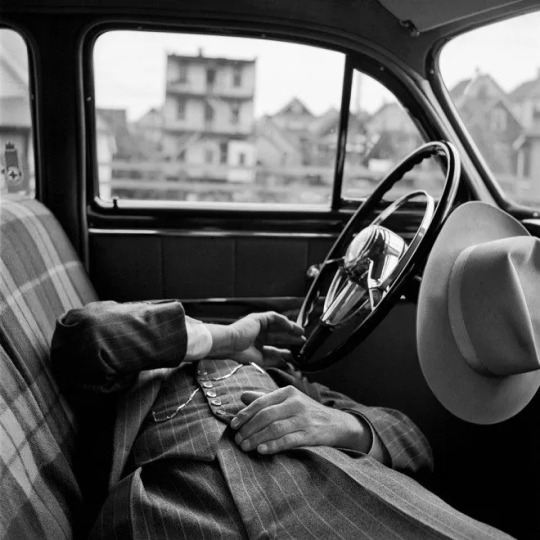
When I started photography, I wanted to become “discovered” to have my work recognized and appreciated. I wanted to be in famous galleries, exhibitions, and museums. I wanted to be a photography household name.
But what I discovered through Vivian Maier is that being “discovered” is mostly luck. If Vivian Maier work didn’t happen to found by John Maloof, her work would’ve disappeared into obscurity. Even though she was incredibly talented, nobody would ever know her work.
Takeaway point:
You can be the most talented photographer in the world and never receive recognition for it. To gain recognition does involve a lot of luck, knowing the right people, and being in the right space at the right time.
So don’t let your popularity dictate your self-worth in photography. There are tons of incredibly talented photographers out there who still haven’t been “discovered” because they don’t know how to market their work via the internet to the masses.
Photograph for yourself, and if you happen to become “discovered” appreciate it. If you never do, don’t worry. Just keep shooting for yourself.
Conclusion
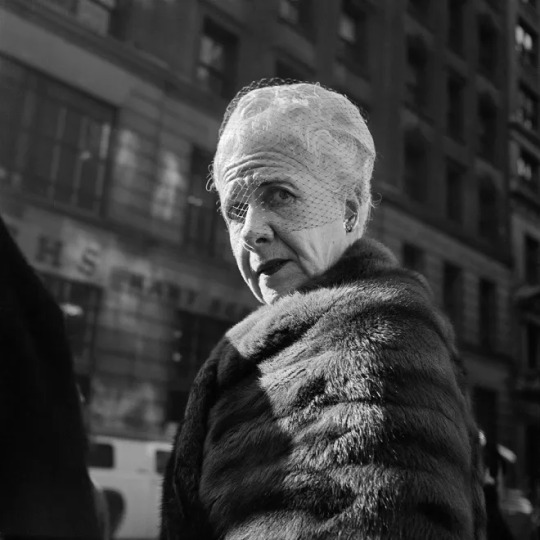
Vivian Maier has taught me the importance of shooting for myself, and not worrying so much about what others think about me and my work. I think she is a great reminder to all of us– that the most people to impress with our work is ourselves.
0 notes
Text
Rush Hour Research
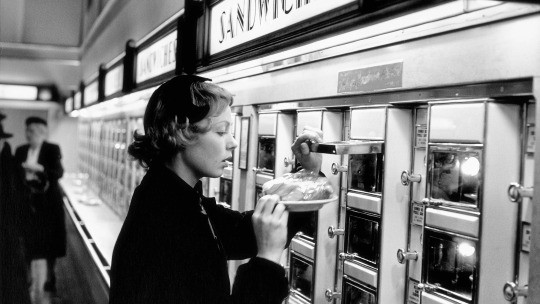



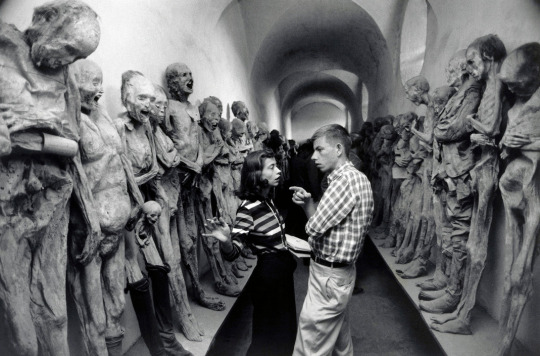
©Elliot Erwitt
Erwitt's use of black and white is beautifully balanced and effective. He seems to have a really keen eye for interesting compositions with his surroundings. He uses what is in front of him as tools to crafting surreal stories, often being quite comedic.
Tom Wood

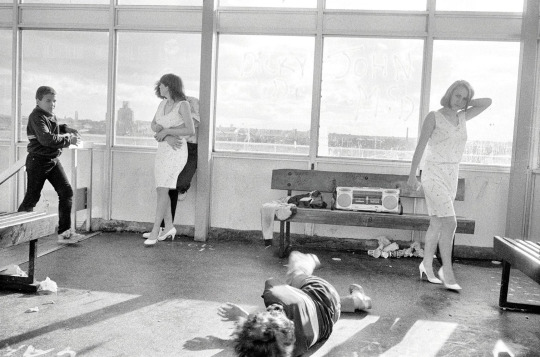

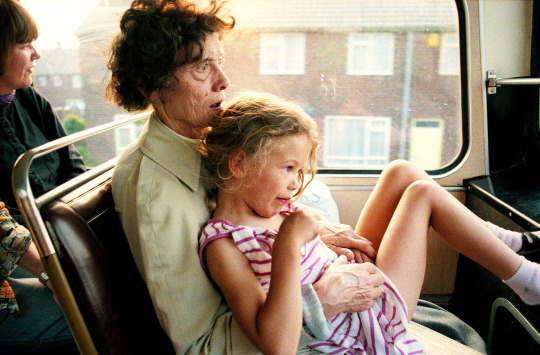

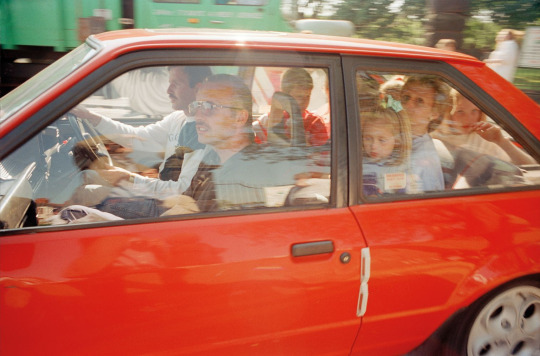
©TomWood
Tom Wood images really capture energy and movement of the environments he is working within. There is a real cinematic feel, there is often little engagement with the photographer in the images, hardly noticing him, if at all which to me makes Wood's images all the more engaging and like a still from a film
Helen Levitt
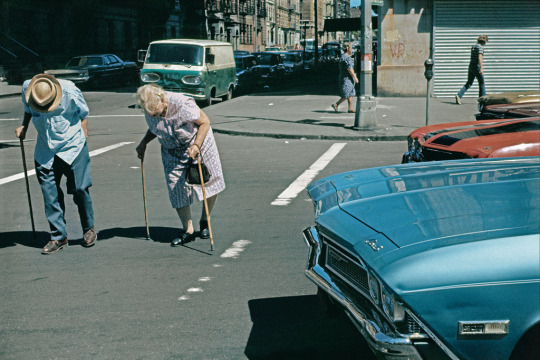
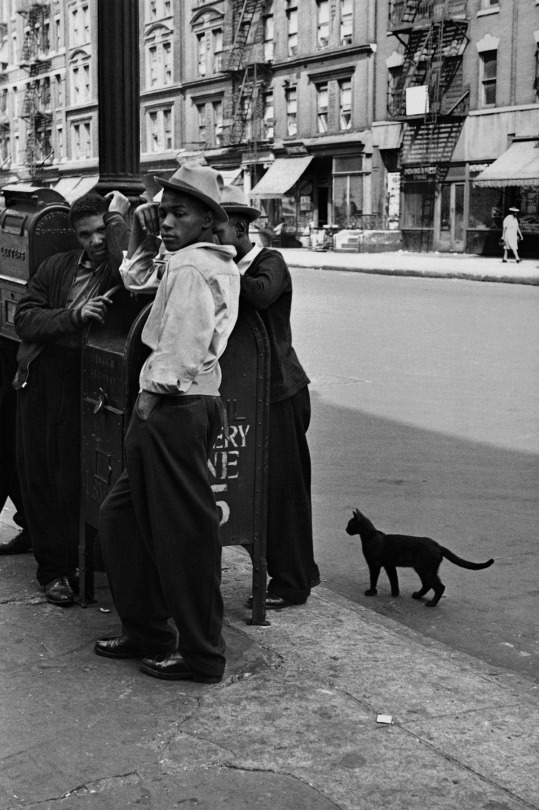


Levitt's black and white images were from the beginning of her photography career much of which focused on children in working and middle class communities on the streets as well as minorities living in New York. Her black and white images are very heart warming and there is a clear difference in those 20-30 years between her black and white, and colour years. Her colour work is a lot more grotesquely humorous, she has a keen eye for subjects and knows when to snap at the right moment. A simple facial expression being snapped at the right moment, a person posture, something going on in the background, brings so much character to her images and creates almost a cartoon-like story.
Joel Meyerowitz

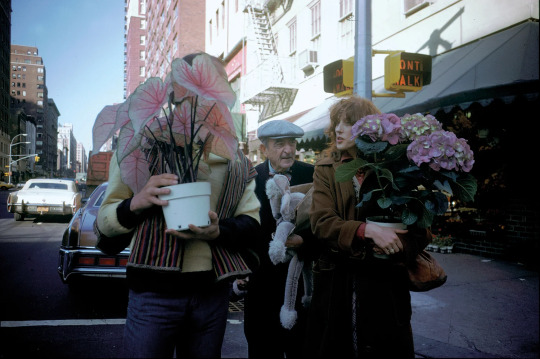

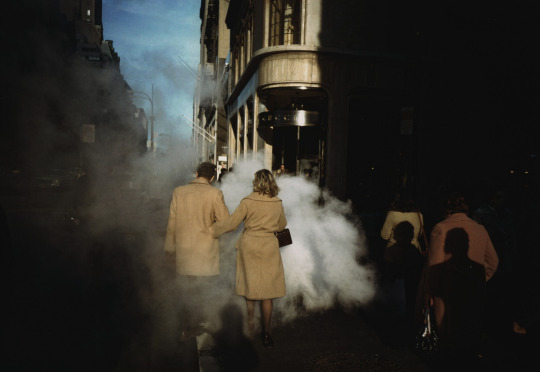
Meyerowitz has clearly mastered the skill of working quickly and has a keen eye for things to photograph, capturing it at the right second which makes the mundane suddenly obscure. Leaving room for stories to be interpreted.
Vivian Maeir

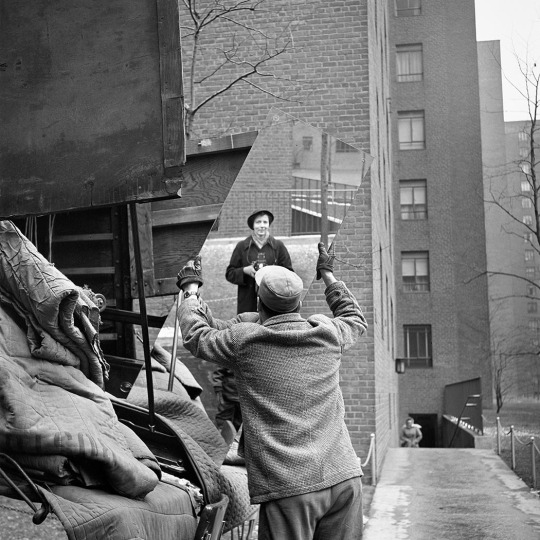

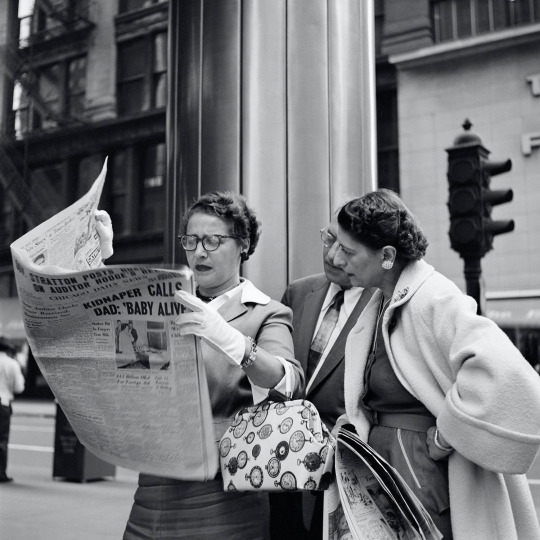

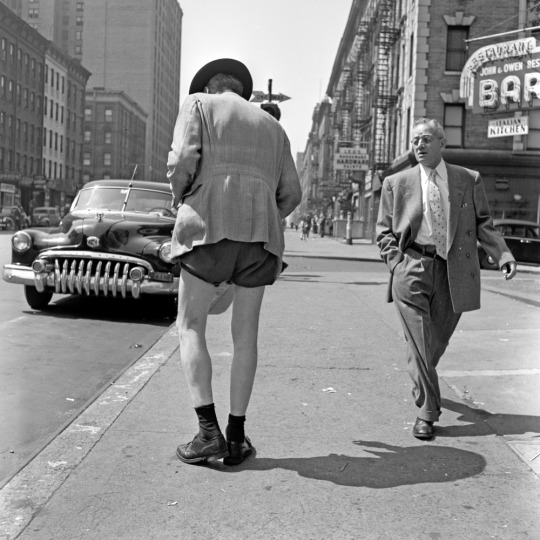
To me, Maier's images have a different to the previous photographers. For most of these image , it is obvious she is getting up close to her subjects, perhaps even vaguely interacting with some to get their attention. There is a slight invasive feel; invasive being used in the most loose form. I mean it feels as though she is get too close for comfort from the subject's perspective, a subject in detached society likely not wanting to be bothered but for a moment we enter a second of their lives. The tone in her images are well balanced.
0 notes
Text
Blogpost #5

Joel Meyerowitz
Camel Coats, New York City, 1975
This snapshot of New York street life in the 1970s creates a sense of movement through the smoke and the shadows. It also has a nice balance of colors. Just as Joel Meyerowitz said in Everybody Street, photography is about going out there and watch people doing things. Even the simplest scene has dynamic moments in it.
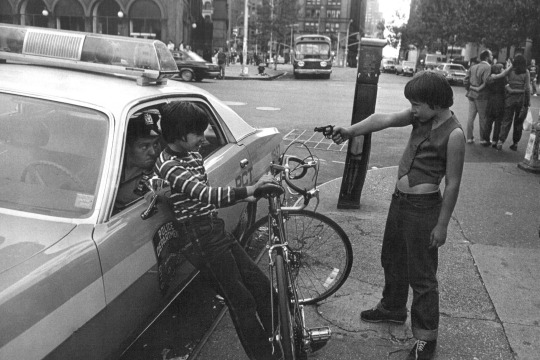
Jill Freedman
Gun Play, Street Cops, 1979

Jill Freedman
Surf'n Turf, New York City, 1979
In Everybody Street, I was impressed by Jill Freedman's strategy of actively talking to her subjects and her courage of working with NYPD at crime scene.
Gun Play, Street Cops, one of her photos of children, vividly depicts the gun play between two kids. The police officer in the back makes the story more dramatic. The other Jill's photo I posted here, Surf'n Turf, also amuses me by contrasting a homeless man with paintings of houses.
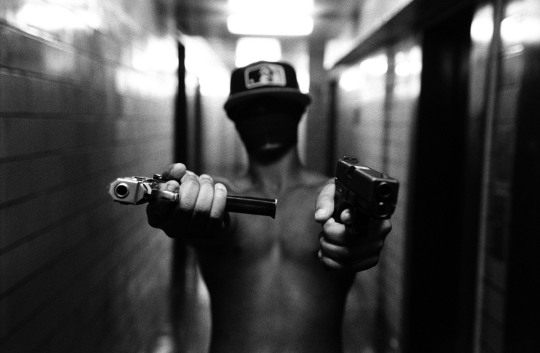
Boogie
It's all good
This visually impactful photo reveals the dark side of New York people seldom encounter. You can actually feel the pressure coming from the in-focused guns and shadowed face. Boogie defined himself completely as an observer, which inspired me to be less aware of my own existence when shooting.
0 notes
Text
Wednesday class 21/09/22: Everybody street

During class we watched a video to help us better prepare for the Rush Hour project.
EVERYBODY STREET, directed by Cheryl Dunn ("102 Minutes that Changed America"), highlights the lives and work of New York's iconic street photographers.
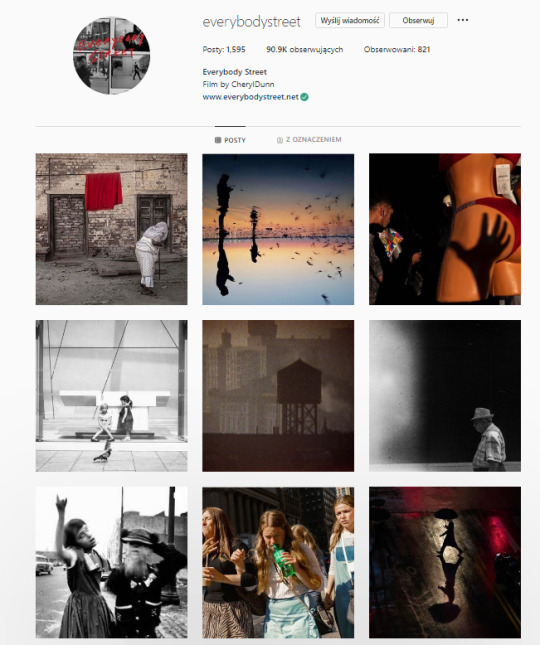
A few names appearing in the film that caught my interest were:
Boogie - Serbia’s most accomplished photographer. He began his career stalking the streets of 1990s Belgrade, documenting the hopelessness and melancholy that choked the city throughout the Milošević years. His raw, monochrome aesthetic was perfectly suited to capturing the feeling of despair that defined the Serbian capital at the time, and his early work represents an emotionally vivid time capsule from that era. He also created a series images It’s All Good, are filled with shots of gangsters showing off their guns and cash, heroin addicts plunging syringes into their veins, and the more mundane, slow, oppressive grind of everyday life in New York

Jill Freedman was a highly respected New York City documentary photographer. In seven books and numerous gallery exhibitions and journalism assignments, she specialized in finding people on the rough margins of American life, rendering them as noble but not necessarily heroic.
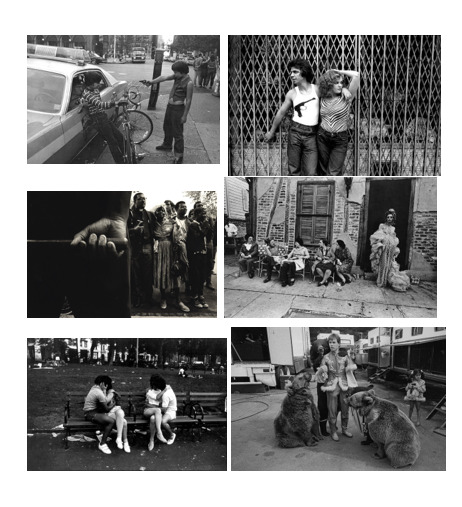
Bruce Gilden - An Iconic street photographer with a unique style, was born in Brooklyn, New York in 1946. Right from childhood, he has always been fascinated by the life on thestreets and the complicated and fascinating motion it involves.

also in the movie you can meet the work of other outstanding phorographers: Bruce Davidson, Elliott Erwitt, Joel Meyerowitz, Rebecca Lepkoff, Mary Ellen Mark, Jeff Mermelstein, Clayton Patterson, Ricky Powell, Jamel Shabazz, Martha Cooper
0 notes
Text
Photobook Inspiration
In order to discover more inspiration and a better knowledge of what to produce, I wanted to explore more deeply into the links supplied in Canvas and briefly examined during class. Through this additional research, I was able to find some excellent links.
1. Perfect Strangers: New York City Street Photographs
Photographs by Melissa O’Shaughnessy. Introduction by Joel Meyerowitz.
Reference: https://aperture.org/books/perfect-strangers-new-york-city-street-photographs/

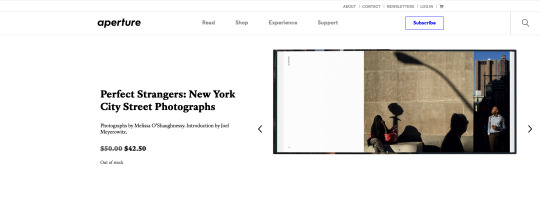
Photographing the streets of New York on a daily basis. We see the play of human activity on the city's sidewalks. Her ensemble of characters includes the lonely, the soulful, and the proud. She's fallen for them all—complete strangers. This has encouraged me to capture some photographs and more of what life is like back home in South Auckland and now in Auckland CBD, providing insight into this contrast via everyday living.
2. Concrete Stories
Romain JACQUET-LAGREZE
Publisher: Asia One
Reference: https://www.shashasha.co/en/book/concrete-stories


Hong Kong's urbanisation and the link between structures and the people who occupy them. Jacquet-Lagrèze uses buildings, rooftops, skyscrapers, and courtyards as settings to portray short stories about people. Couples holding hands, ladies hanging clothing to dry, and individuals watering their plants can all be found within a mosaic of window frames, balconies, air conditioners, and building components. I am motivated to employ this in my own work by photographing the architecture in my studio apartment as well as inside my family's home. Again, the contrasting contrast and how different the two locations are. The implementation of this notion will give my story a fresh tone through architecture.
0 notes